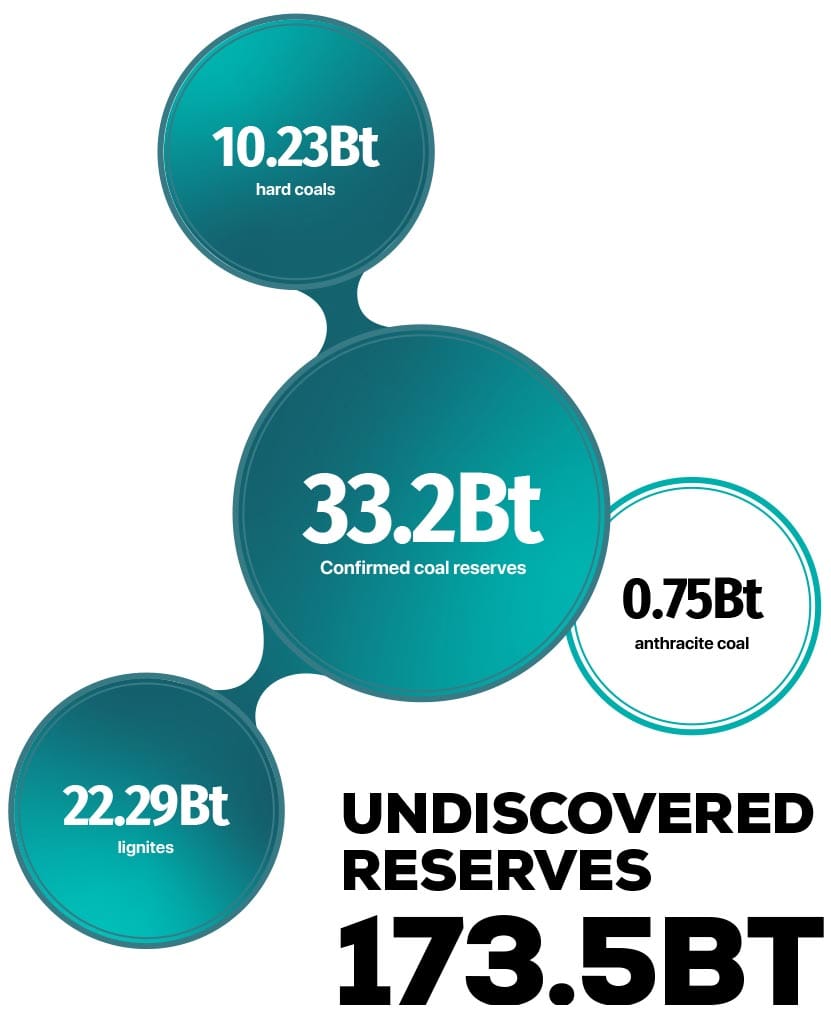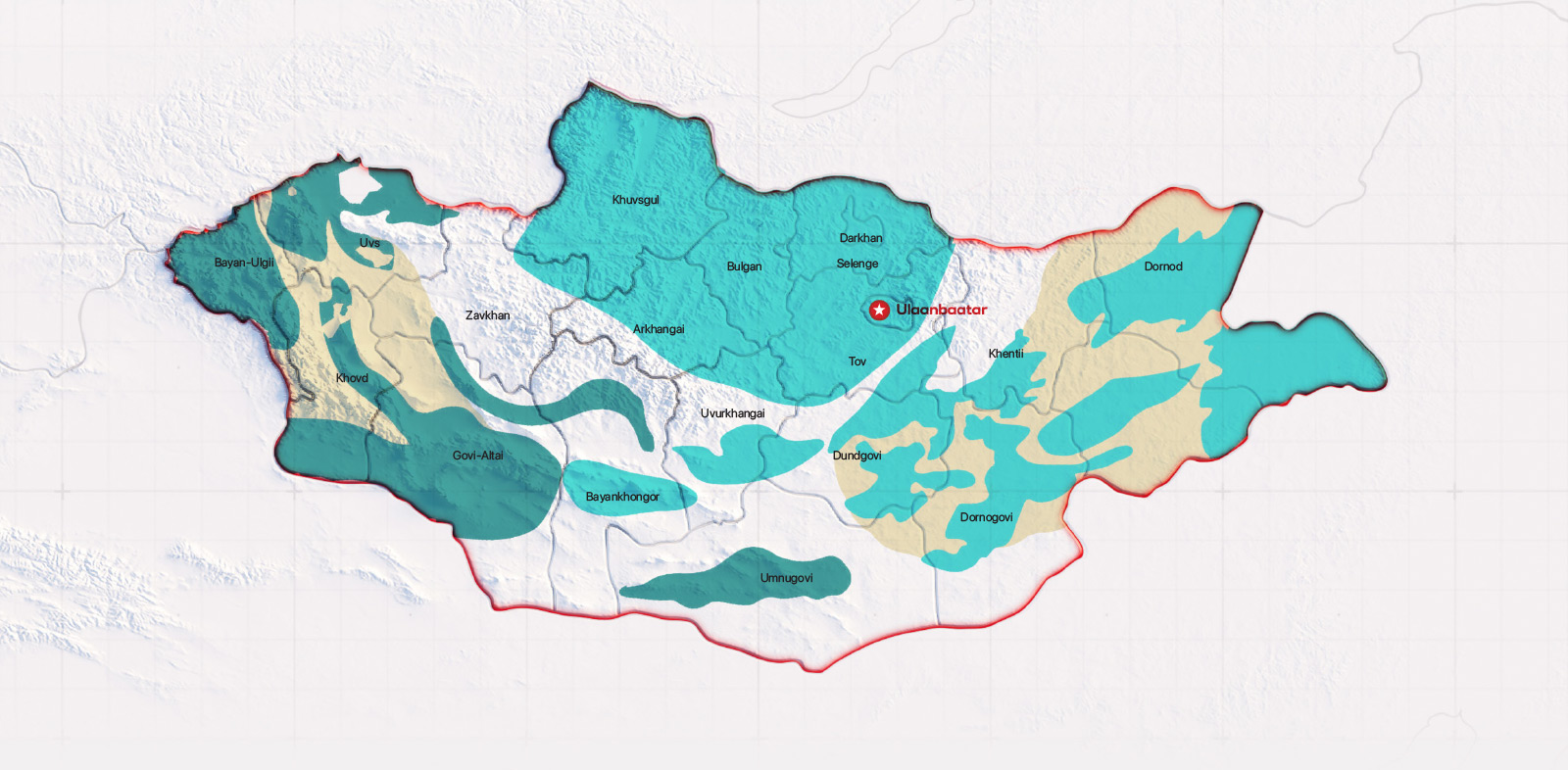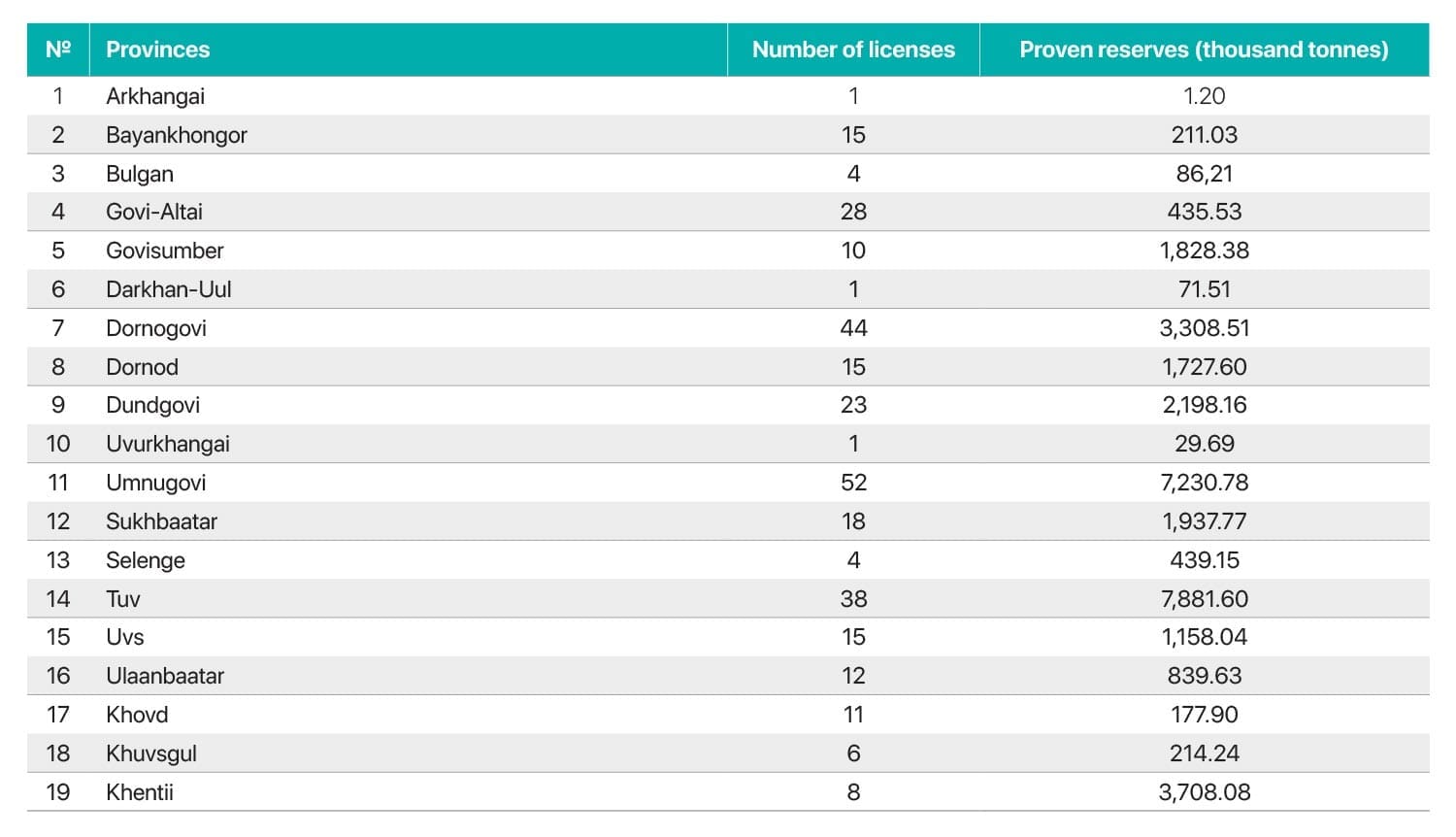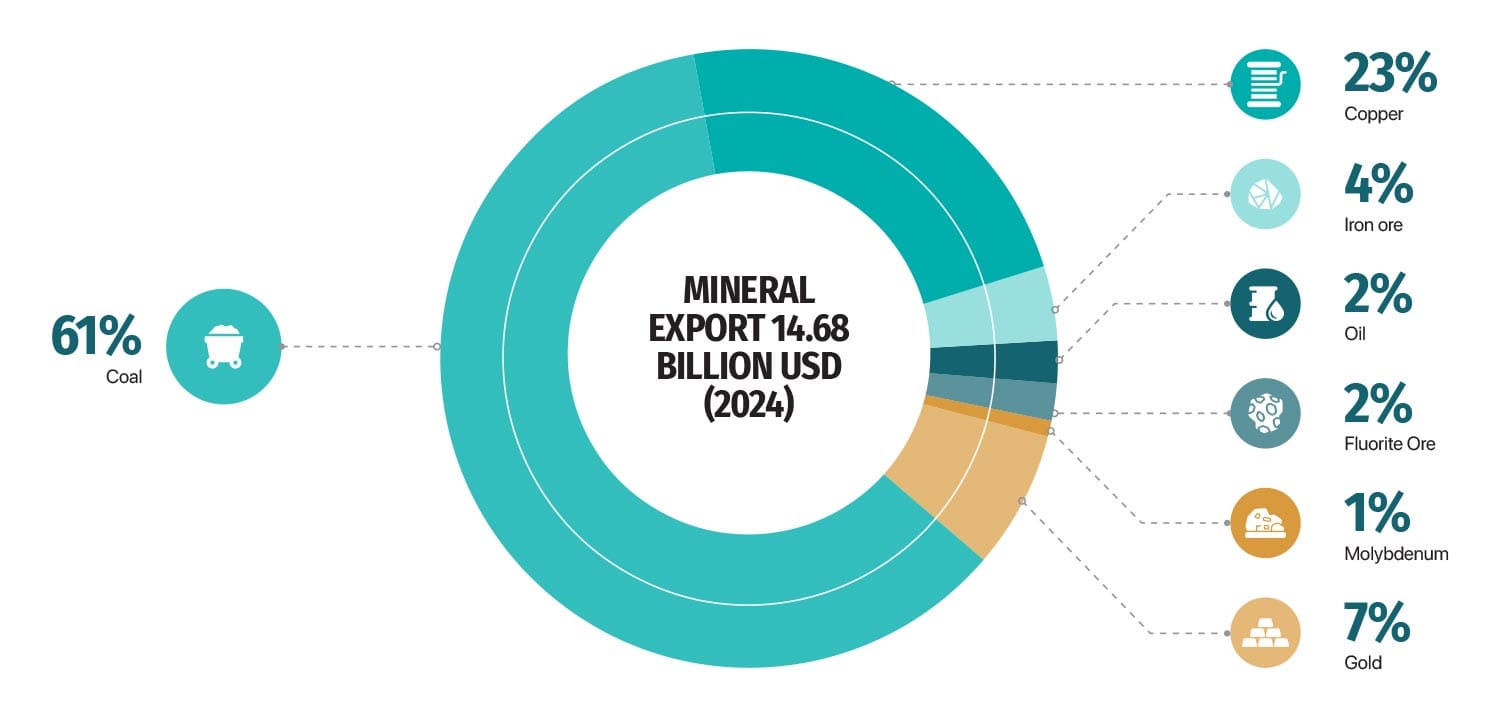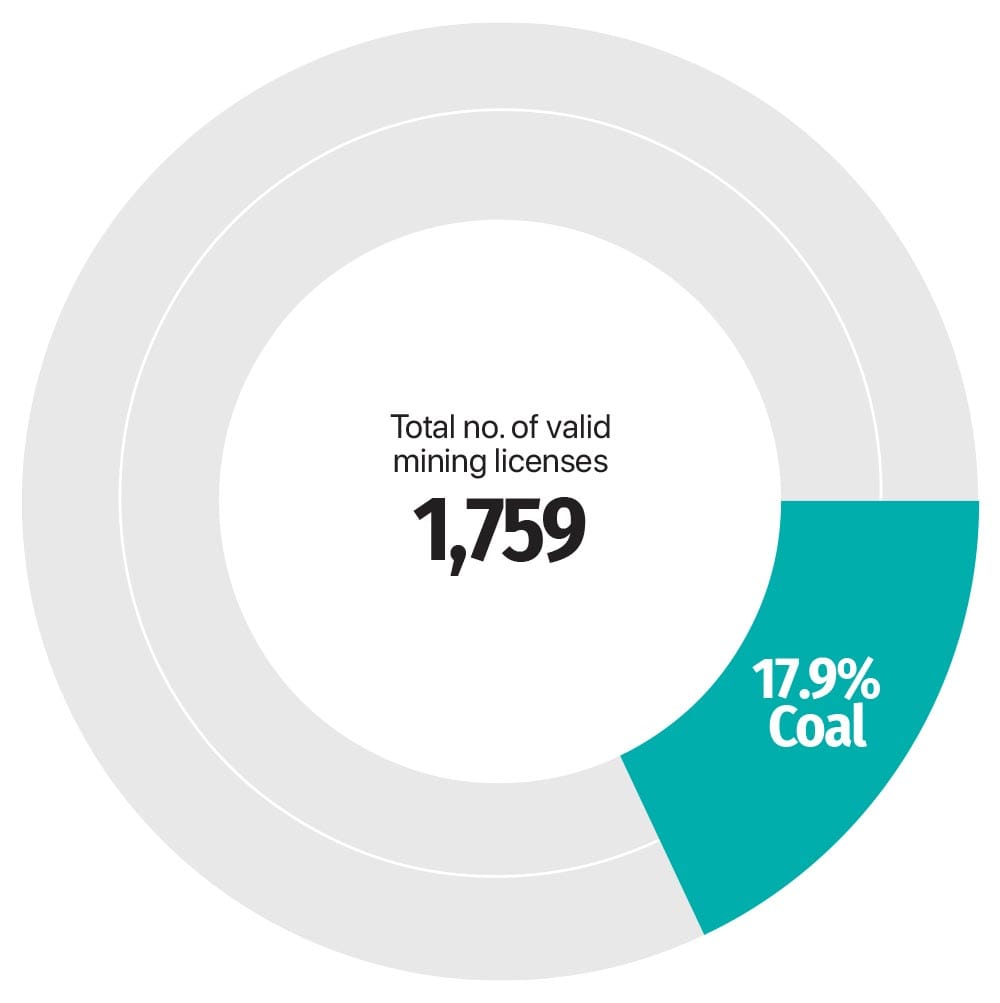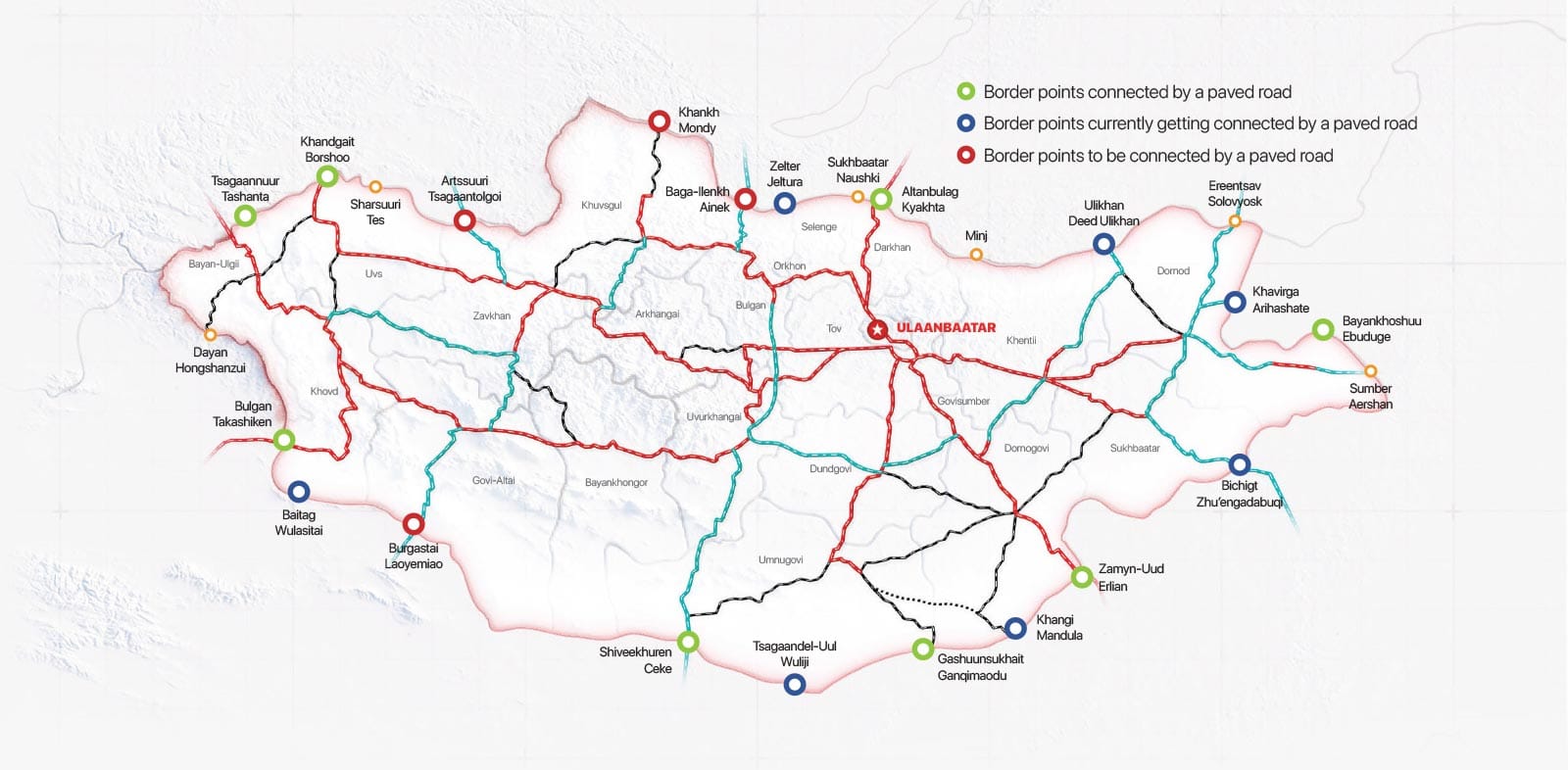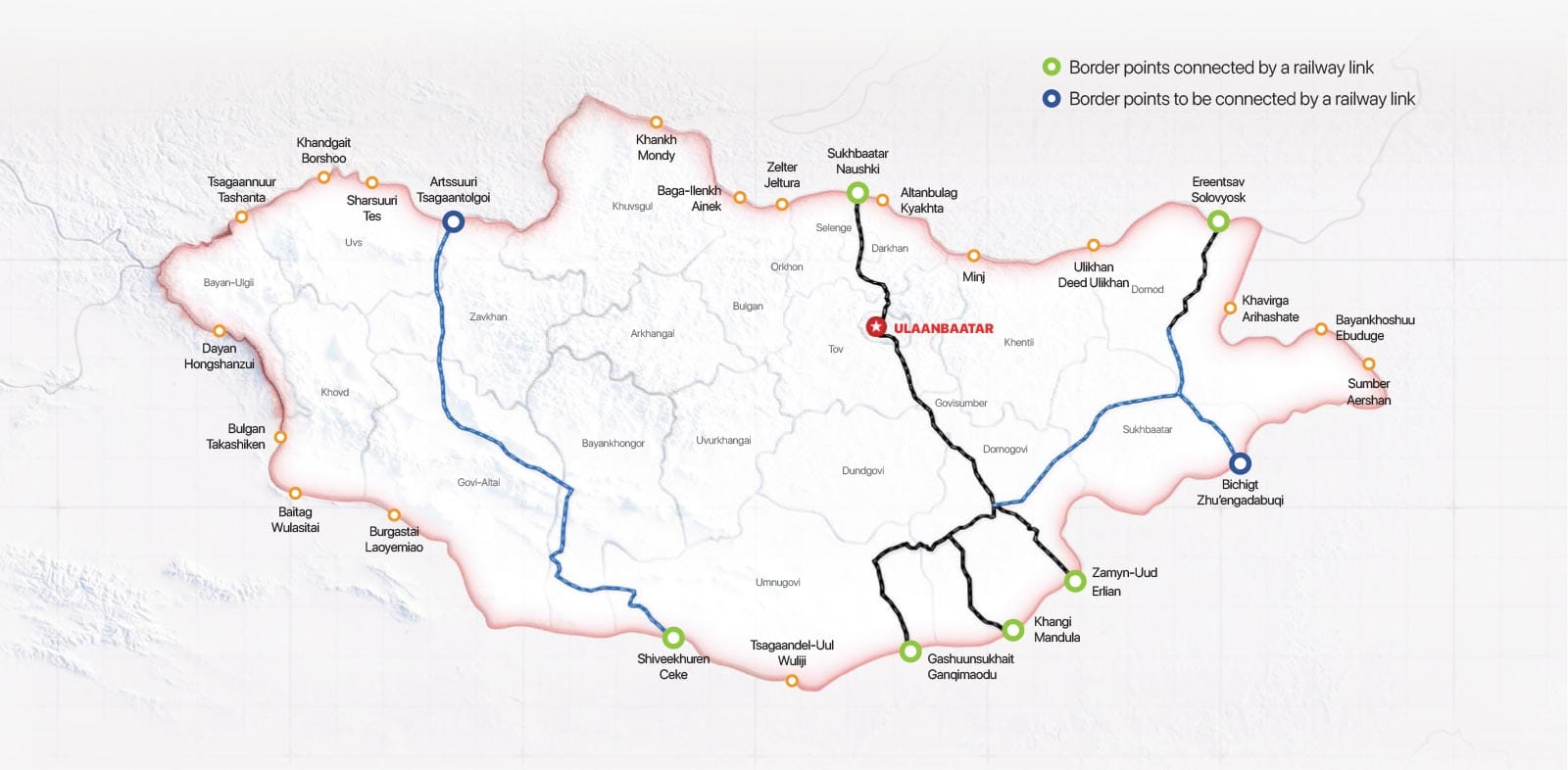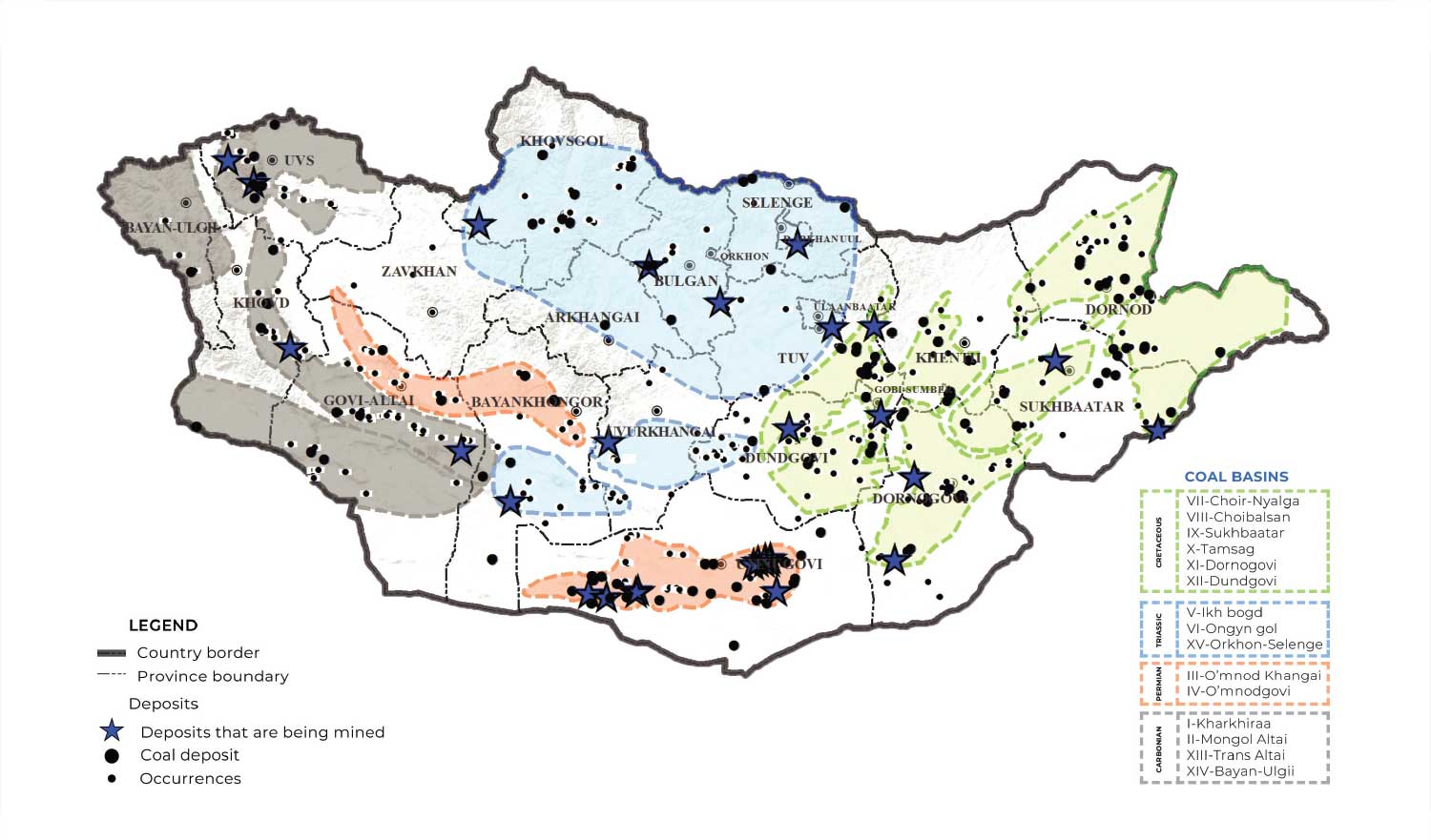Highlights
Mongolia ranks 23rd globally in terms of coal reserves and 17th in coal mining. The largest consumer of this vast coal resource is China. In 2023, Mongolia alone supplied 50% of China’s coking coal demand, becoming one of the leading competitors in China’s market.
In 2024, coal exports reached a remarkable level of 83.7 million tonnes, marking the first time in history that Mongolian coal exports surpassed 80 million tonnes.
Reserves
Throughout the country, 15 basins consist of three types of coals, holding a confirmed coal reserve of 33.2b tonnes. The Mongolian Coal Association also reports about 173.5b tonnes of undiscovered reserves that additional geological surveys can unearth.
As of 2024, there are a total of 314 valid coal mining licenses in the country.
Coal resource distribution map
Source: The Mineral Resource and Petroleum Authority of Mongolia
COAL RESERVES BY PROVINCE AS OF 2022
Source: The Mineral Resource and Petroleum Authority of Mongolia
The table shows all confirmed coal reserves. As of 2022, total reserves currently stand at 33.2b tonnes. Information was collected from the 177 coal producers within the framework of the 307 coal mining licenses already issued, reviewed by the Mineral Resources Professional Council, and submitted to the Mineral Resource and Petroleum Authority of Mongolia.
Mongolia’s coal reserves are relatively evenly distributed across five regions: Central, Khangai, Gobi, Western, and Eastern.
The majority of Mongolia’s coal reserves are concentrated in the Eastern and Gobi regions.
Approximately 80% of Mongolia’s total coal reserves consist of lignite (brown coal).
The country’s largest coal deposits include Baganuur, Sharyn Gol, Shivee Ovoo, Nariin Sukhait open-pit mine, and the Tavan Tolgoi coal deposit.
Among these, Tavan Tolgoi is recognized for its high-quality coking coal, which has superior characteristics in terms of ash content, moisture, sulfur content, and calorific value. Additionally, its proximity to China (approximately 250 km) provides a significant logistical advantage for exports.
At the Tavan Tolgoi deposit, coal is extracted and exported to China by three major entities:
- Erdenes Tavan Tolgoi (a state-owned company),
- Tavan Tolgoi JSC (a joint ownership between local government and private investors), and
- Mongolian Mining Corporation (MMC), which is listed on the Hong Kong Stock Exchange.
In September 2024, Erdenes Tavan Tolgoi announced that, based on comprehensive exploration and studies conducted from 2017 to 2023, the company’s licensed area holds 8.1 billion tonnes of coal reserves.
Production & exports
The coal industry as a percentage of overall exports exceeded copper in 2010, and its contribution to the state budget also surpassed copper, becoming the biggest driver in the country’s economy. Mongolia single-handedly supplies 50% of China’s total coal consumption and is one of the biggest players in the coking coal industry.
Mineral exports by type
COAL EXPORTS (IN MILLION TONNES)
Source: NSO of Mongolia
COAL PRODUCTION (IN MILLION TONNES)
Source: NSO of Mongolia
FISCAL REVENUES FROM COAL (IN BILLION MNT)
Source: Ministry of Industry and Mineral Resources
COAL MINING LICENSES (NUMBER AND TOTAL AREA)
As of 2021, 44 coal mines are currently operating in the country, and 65% of them are hard coal mines.
Infrastructure
Mongolia exports coal via five border checkpoints, namely Gashuunsukhait, Shiveekhuren, Khangi, Bichigt, and Bulgan. The majority of exports flow through via Gashuunsukhait-Ganqimaodu port and the Shiveekhuren-Ceke crossing.
% of coal exports key border crossings
Source: Mongolian Coal Association
BORDER CROSSINGS
Source: Ministry of Road and Transports of Mongolia
Coal is exported both by road and rail, with the majority of exports still being transported across the border to China via road. Only a small portion – or just under 1%, is transported is exported via the Zamyn-Uud-Erlian border crossing.
A number of public and private partnerships exist on road and railroad construction projects, ultimately helping to boost coal exports:
RAILWAY BORDER CROSSINGS
Source: Ministry of Road and Transports of Mongolia
The Government of Mongolia has a plan to enhance the country’s railway system. In 2023 alone, three major railway projects were completed, and more are in the pipeline.
1. Tavan Tolgoi - Zuunbayan railway project
The railway along the Tavantolgoi – Zuunbayan route is expected to have annual capacity of 15 million tonnes of freight with the potential to double.
- Continuous length: 416.1 km
- Location: From Tavan Tolgoi coal deposit in Tsogttsetsii soum, Umnugovi aimag to Zuunbayan in Dornogovi aimag, covering Tsogttsetsii and Manlai soums of Umnugovi aimag, Mandakh and Zuunbayan baghs of Sainshand soum in Dornogovi aimag.
- Annual capacity: 15 million tonnes of cargo
2. Tavan Tolgoi - Gashuunsukhait railway project
Tavantolgoi – Gashuunsukhait railway has an annual capacity of 30-50 million tonnes of freight transportation. A total of 2 million tonnes of freight were transported by Tavantolgoi – Zuunbayan and Tavantolgoi – Gashuunsukhait railways in 2023.
- Continuous length: 233.6 km
- Location: Continues from the Tavan Tolgoi coal deposit in the South Gobi to the Gashuunsukhait border crossing.
3. Zuunbayan - Khangi railway project
Zuunbayan – Khangi railway is set to increase the export value of over 10 deposits in the Gobi region.
- Continuous length: 226.9 km
- Location: The railway starts at the Zuunbayan station of the Ulaanbaatar Railway in Zuunbayan bagh, Sainshand soum, Dornogovi aimag, and run to Khangi port, connecting it to the Chinese port of Mandal
The Khangi port is strategically located in the middle of Gashuunsukhait, the main coal and copper export port, and Zamyn-Uud, the main import port.
4. Shiveekhuren - Ceke railway project
The construction of the 6.9 km Shiveekhuren – Ceke railway has also been completed in 2024. The connection of the two ports marks the beginning of the western vertical axis Shiveekhuren-Nariinsukhait-Artssuuri railway, a cross-border railway of the “Economic Corridor” of Mongolia, Russia, and China.
However, to fully utilize these railways for freight transport at their full capacity, it is essential to establish cross-border railway connections with China. The government has included the construction of cross-border railways and freight transfer terminals at the Gashuunsukhait-Gantsmod, Khangi-Mandal, and Shiveekhuren-Ceke border points in its action program and is working toward implementation as of February 2025.
Once these three railways are fully operational, export capacity will increase by 20 million tonnes at the Gashuunsukhait-Gantsmod port, 10 million tonnes at the Khangi-Mandal port, and 10 million tonnes at the Shiveekhuren-Ceke port.
The newly constructed railways are critically important projects for increasing the transportation of mining products to China for export.
Within the framework of the government’s action program for 2024-2028, the following new railways are planned for construction:
- The Central Corridor Railway, connecting Altanbulag to the Khangi port.
- The Eastern Vertical Railway, linking Ereentsav to the Bichigt port.
- The Western Vertical Railway, from Arts Suuri to Nariin Sukhait and Shiveekhuren.
- The Horizontal Corridor Railway, connecting these routes across the country.
These railway projects aim to further enhance Mongolia’s transportation infrastructure and export capacity
Coal Processing Industry
Mongolia’s policy is to process their own coal, thereby adding more value to the industry prior to exporting abroad. Although coal accounts for over 54.1% of total exports, coal processing only accounts for about 20% of all coal exports. Current state policy is focused on increasing the number of coal processing plants.
About 30 coal processing plants currently operate in Mongolia, out of which about 21 deploy the wet method, with the remaining amount being processed using dry method technologies.
Mongolia’s first-ever coal processing plant was established in 2011 by Energy Resource LLC within the framework of the Ukhaa Khudag project. Built with three phases, each phase of the plant is capable of washing and processing 5m tonnes of coal each year. Within a decade after becoming operational, the plant had processed a total amount of 62m tonnes of raw coal, produced 31m tonnes coking coal, and refined 12.5m tonnes of thermal coal.
Located in the Nariin Sukhait of Umnugovi province, MAK’s processing plant has an annual processing capacity of 1m tonnes of coal. The plant, which is currently running at 65% of output capacity, uses 100 liters of water and recycles 92% of the used water. Capacity can be further expanded to 5m tonnes.
In April 2021, the Mineral Resources Professional Council reviewed and accepted the feasibility study of the Tavan Tolgoi coal processing plant. The plant is expected to have three building blocks with a processing capacity of ten million tonnes per annum each and a total capacity of 30 million tonnes per year. In 2024, the first phase of the coal processing plant project, with a capacity to process 10 million tonnes of coal per year, was put into operation.
In December of the same year, the coal processing plant’s the first product, 12.8 thousand tonnes of processed coking coal was sold through an open auction on the Mongolian Stock Exchange and transportation began.
Coal companies
The Mongolian state-owned Erdenes Tavan Tolgoi, the Mongolian Stock Exchange-listed Tavan Tolgoi JSC, and the Hong Kong Stock Exchange-listed Mongolian Mining Corporation (also known as Energy Resource LLC) all operate coal mines at the Tavan Tolgoi coal deposit. These three projects account for over half of Mongolia’s coal exports.
The state-owned company, Erdenes Tavan Tolgoi, commenced raw coal production in 2010 and became the first domestic company to exceed $1 billion in sales revenue in 2019.
Mongolian Mining Corporation (also known as Energy Resource LLC) is Mongolia’s largest producer of washed hard coking coal. The company owns the Ukhaa Khudag deposit, which is part of the Tavan Tolgoi coal deposit, as well as the Baruun Naran coking coal deposit, both located in the South Gobi region of Mongolia.
Additionally, several companies—including SouthGobi Resources, Usukh Zoos, and Mongolyn Alt Corporation—operate coal mines at the Nariin Sukhait coal deposit, located over 400 km from Tavan Tolgoi. These companies extract and export coal.
The Nariin Sukhait coal deposit holds approximately 380 million tonnes of high-rank, low-ash, low-sulfur metallurgical and steam coal resources.
Location map of coal deposits and occurrences in Mongolia, scale 1: 12 000 000
Source: National Geology Survey of Mongolia
In the western part of Mongolia, Mongolia Energy Corporation (MEC) operates Khushuut Coking Coal Projects which is located approximately 1,350 km west of Ulaanbaatar in the Khovd Province of Mongolia. It is about 311 km from the Xinjiang Takeshiken border, connected by the Khushuut Road. The company, listed on the Hong Kong Stock Exchange, sells coking coal and thermal coal to Northern China.
Another highly prospective major coal deposit is Aspire Mining Limited’s project.
Aspire Mining Limited is an Australian Stock Exchange-listed 100% metallurgical coal and rail company with a 100% interest in the world-class Ovoot Coking Coal Project and a 90% interest in the Nuurstei Coking Coal Project. Aspire’s flagship Ovoot project, located in Khuvsgul Province of Mongolia, hosts 255 Mt JORC Coal Reserves.
The company has not yet started its coal project, postponing its implementation.
The Government of Mongolia’s 2024-2028 Action Plan outlines 14 mega projects under four key policy directions. The first of these projects is the construction of cross-border railway connections and cargo transshipment terminals at the Gashuunsukhait-Ganqimaodu, Khangi-Mandula, and Shiveekhuren-Ceke border ports.
The implementation of this project is expected to increase total export capacity by 40 million tonnes, with:
- Gashuunsukhait-Ganqimaodu port increasing by 20 million tonnes,
- Khangi-Mandula port increasing by 10 million tonnes, and
- Shiveekhuren-Ceke port increasing by 10 million tonnes.
As a result, export revenues are projected to double, and coal export capacity via railway is expected to triple.
The government aims to:
- Construct cross-border railway connections,
- Develop paved roads linking border ports, and
- Build cargo transshipment terminals.
With these infrastructure developments, Mongolia’s annual mining product exports are projected to reach 100 million tonnes.
